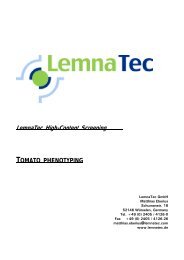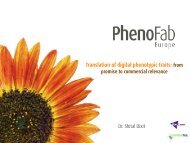Cereal NIR/SWIR phenotyping - LemnaTec
Cereal NIR/SWIR phenotyping - LemnaTec
Cereal NIR/SWIR phenotyping - LemnaTec
You also want an ePaper? Increase the reach of your titles
YUMPU automatically turns print PDFs into web optimized ePapers that Google loves.
<strong>LemnaTec</strong> High-Content Screening<br />
CEREAL <strong>NIR</strong>-PHENOTYPING<br />
<strong>LemnaTec</strong> GmbH<br />
Matthias Eberius<br />
Schumanstr. 18<br />
52146 Würselen, Germany<br />
Tel. +49 (0) 2405 / 4126-0<br />
Fax +49 (0) 2405 / 4126-26<br />
matthias.eberius@lemnatec.com<br />
www.lemnatec.de
Near Infrared Imaging (<strong>NIR</strong>)<br />
Near infrared (<strong>NIR</strong>) or short-wave IR-imaging (SW-IR) can be used, for example, to get<br />
detailed information on the watering status of plant leaves and their reaction to limited<br />
water availability or external drought (e. g. during growth or storage periods). The<br />
following image shows how a representative of cereals (in this case wheat) generally<br />
dries down over time, changing the <strong>NIR</strong>-absorption of the leaves in the <strong>NIR</strong>-absorption<br />
band between 1,450 and 1,600 nm.<br />
Figure 1: A bunch of wheat dries down in warm ambient conditions. <strong>NIR</strong>-imaging<br />
shows a strong increase in reflectance as the water in the leaves is extremely reduced.<br />
Blue/green false colours represent high water content, while yellow/red colours<br />
symbolise low water content (high reflectance).<br />
2
This wheat test with its fast reaction to drought is just one application example of <strong>NIR</strong>imaging;<br />
in this case it is used to quantify the water dynamics in plants.<br />
Similar tests can of course be carried out with various plants, even in pots, to assess<br />
their reactions to water stress under drought conditions.<br />
The diagram below shows the quantitative data, expressed as false colour classes, of<br />
several absorption ranges.<br />
Fig. 2: The drying dynamics of a wheat plant over a 12 hour period. Blue/green false<br />
colours represent high water content, while yellow/red/violet colours symbolise low<br />
water content (high reflection).<br />
Figure 2 shows how non-destructive imaging generates high-content data on water<br />
loss dynamics. The sensitivity of the technology is clearly revealed by the fact that<br />
within the first few hours significant changes towards drying down are already<br />
depicted as major shifts between the colour classes.<br />
Conclusion<br />
The <strong>LemnaTec</strong> Scanalyzer is a comprehensive <strong>phenotyping</strong> platform highly suitable to<br />
quantify morphological traits e. g. of cereals like wheat – and in fact any other plant –<br />
over the whole length of an entire life cycle.<br />
The example above provides only a first impression of the unlimited capabilities of the<br />
system concerning the quantitative characterisation of water dynamics in vegetables and<br />
other plants. All results based on biologically relevant parameters that are generated in<br />
this way will be reproducible.<br />
3
Moreover, the <strong>LemnaTec</strong> systems can be customised for various applications, depending<br />
on individual research requirements.<br />
For further information please contact<br />
Matthias Eberius<br />
<strong>LemnaTec</strong> GmbH<br />
Schumanstr. 18<br />
52146 Würselen, Germany<br />
Tel. +49 (0) 2405 / 4126-0<br />
Fax +49 (0) 2405 / 4126-26<br />
matthias.eberius@lemnatec.de<br />
www.lemnatec.com<br />
4





